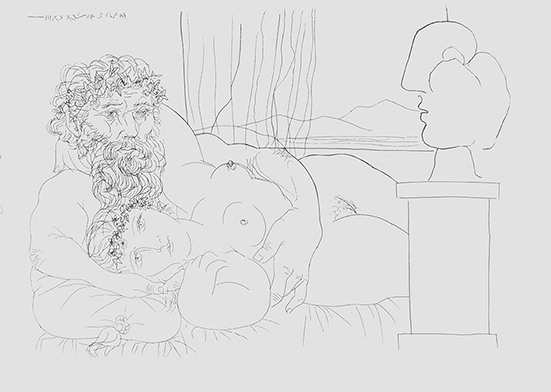Much has been written about Picasso’s epiphany in the presence of African tribal art and whilst his experience was highly personal within two decades it was also part of the Surrealist's zeitgeist. The 1933 issue of Minotaure, in addition to featuring the recently created Une Anatomie drawings, also featured articles on African tribal rituals. Concerning art’s fetishistic power, André Malraux quoted Picasso as saying, “The Negro pieces were intercesseurs, mediators; ever since then I’ve known the word in French. They were against everything—against unknown, threatening spirits. I always looked at fetishes. I understood; I too am against everything. I too believe that everything is unknown, that everything is an enemy!” (Malraux 1976: 11). By memorialising the ‘enemy’ in the form of the ex-votos in the Une Anatomie drawings, Picasso depicted the consequences of the bacteria and at the same time visually contained its life-threatening effect.
The Sculptor’s Studio and The Minotaur
In order to pursue the proposition that the Une Anatomie drawings are ex-voto memorialisations of Marie-Thérèse’s near death illness, we need to further examine Picasso’s creative output before and after their production. The work that preceded the anatomy drawings was the previously discussed Rescue series that provides vivid insights into Picasso’s traumatic reaction to the accident and its consequences. Her eventual recovery then, it is proposed, motivated him to create ex-voto totemic memorialisations of his muse’s illness-ravaged body in the form of the anatomy drawings.
Next, we need to examine the creative output that post-dates Une Anatomie and search for leitmotifs that can shed more light on the anatomy drawings. The artworks that immediately post-date the drawings are 46 etchings on the theme of The Sculptor’s Studio and 11 etchings on the theme of The Minotaur, all of which eventually formed part of the Vollard Suite of 100 etchings. The women in the etchings represent an almost recovered or fully recovered voluptuous Marie-Thérèse, which is the complete opposite to her skeletal appearance in the preceding ex-voto anatomy drawings. Both of the Vollard themes seamlessly merge myth and antiquity in a fantasised neo-classical world torn between Apollonian composure and Dionysian excess, epitomised by emotions ranging from love and empathy to lustful debauchery, which may reflect Picasso’s perception of Marie-Thérèse’s recovery. This duality at the heart of the minotaur's persona is clearly exemplified in Picasso's 1937 water-colour drawing Minotaur rescuing a drowning woman, who appears to be the same woman (Marie Thérèse-Walter) that is depicted in the most discussed painting in the Rescue series (fig. 19).
 24
24